MSI Z77A-GD65 Gaming Review
by Ian Cutress on April 18, 2013 12:00 PM EST- Posted in
- Motherboards
- MSI
- Z77
Readers of our motherboard review section will have noted the trend in modern motherboards to implement a form of MultiCore Enhancement / Acceleration / Turbo (read our report here) on their motherboards. This does several things – better benchmark results at stock settings (not entirely needed if overclocking is an end-user goal), at the expense of heat and temperature, but also gives in essence an automatic overclock which may be against what the user wants. Our testing methodology is ‘out-of-the-box’, with the latest public BIOS installed and XMP enabled, and thus subject to the whims of this feature. It is ultimately up to the motherboard manufacturer to take this risk – and manufacturers taking risks in the setup is something they do on every product (think C-state settings, USB priority, DPC Latency / monitoring priority, memory subtimings at JEDEC). Processor speed change is part of that risk which is clearly visible, and ultimately if no overclocking is planned, some motherboards will affect how fast that shiny new processor goes and can be an important factor in the purchase.
For reference, the MSI Z77A-GD65 Gaming does enable a form of MCT at stock settings.
3D Movement Algorithm Test
The algorithms in 3DPM employ both uniform random number generation or normal distribution random number generation, and vary in various amounts of trigonometric operations, conditional statements, generation and rejection, fused operations, etc. The benchmark runs through six algorithms for a specified number of particles and steps, and calculates the speed of each algorithm, then sums them all for a final score. This is an example of a real world situation that a computational scientist may find themselves in, rather than a pure synthetic benchmark. The benchmark is also parallel between particles simulated, and we test the single thread performance as well as the multi-threaded performance.
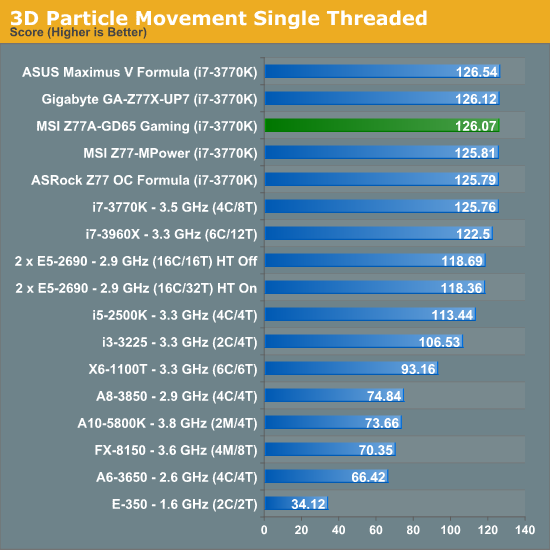
With MCT enabled, the GD65 Gaming hits 3DPM Single Threaded in the middle of the pack at a score of 126.
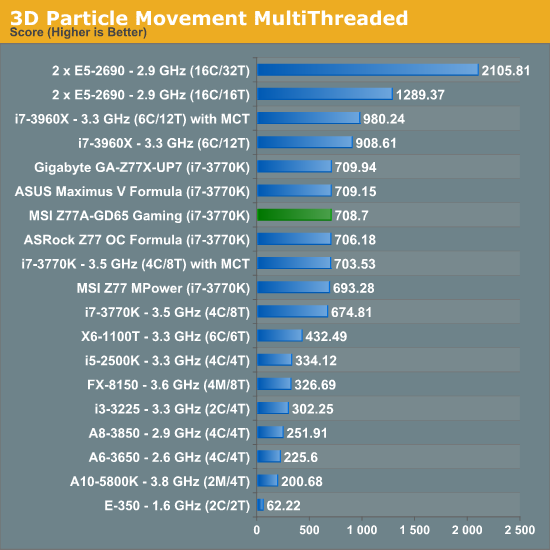
The GD65 Gaming performs well in 3DPM Multithreaded, almost approaching efficiencies seen on the high end ASUS and Gigabyte motherboards.
WinRAR x64 3.93 - link
With 64-bit WinRAR, we compress the set of files used in the USB speed tests. WinRAR x64 3.93 attempts to use multithreading when possible, and provides as a good test for when a system has variable threaded load. If a system has multiple speeds to invoke at different loading, the switching between those speeds will determine how well the system will do.
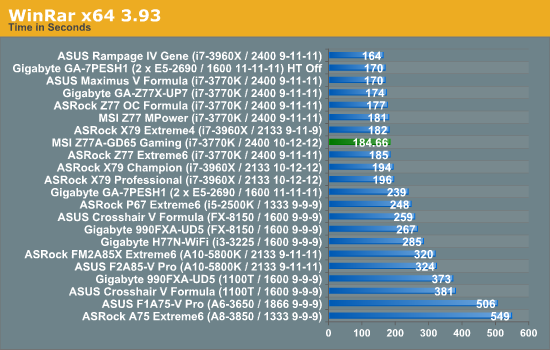
Unfortunately that efficiency in 3DPM is not seen that much in WinRAR, although 184 seconds is no slouch.
Please note we will be updating to WinRAR 4.2 for Haswell. The GD65 Gaming scored 49.65 seconds with v4.2.
FastStone Image Viewer 4.2 - link
FastStone Image Viewer is a free piece of software I have been using for quite a few years now. It allows quick viewing of flat images, as well as resizing, changing color depth, adding simple text or simple filters. It also has a bulk image conversion tool, which we use here. The software currently operates only in single-thread mode, which should change in later versions of the software. For this test, we convert a series of 170 files, of various resolutions, dimensions and types (of a total size of 163MB), all to the .gif format of 640x480 dimensions.
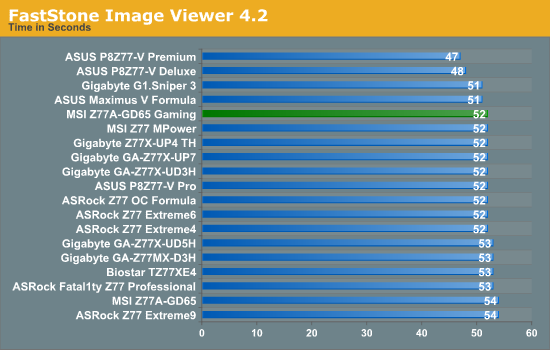
52 seconds is very average for the GD65 Gaming.
Xilisoft Video Converter
With XVC, users can convert any type of normal video to any compatible format for smartphones, tablets and other devices. By default, it uses all available threads on the system, and in the presence of appropriate graphics cards, can utilize CUDA for NVIDIA GPUs as well as AMD APP for AMD GPUs. For this test, we use a set of 32 HD videos, each lasting 30 seconds, and convert them from 1080p to an iPod H.264 video format using just the CPU. The time taken to convert these videos gives us our result.
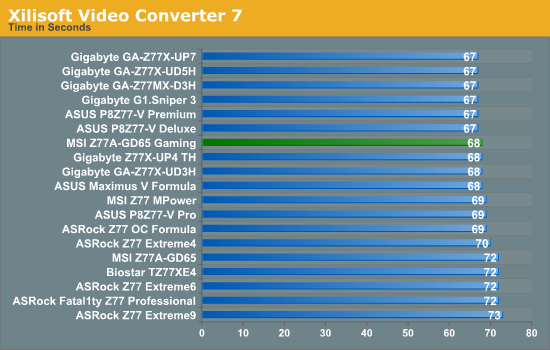
x264 HD Benchmark
The x264 HD Benchmark uses a common HD encoding tool to process an HD MPEG2 source at 1280x720 at 3963 Kbps. This test represents a standardized result which can be compared across other reviews, and is dependant on both CPU power and memory speed. The benchmark performs a 2-pass encode, and the results shown are the average of each pass performed four times.
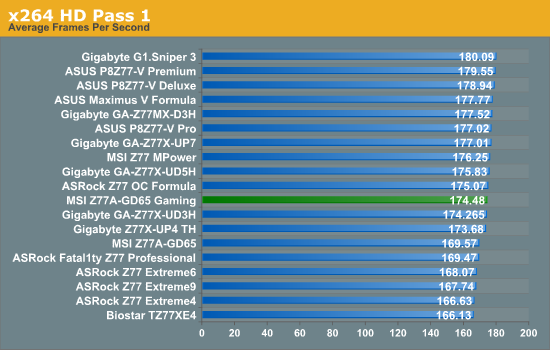
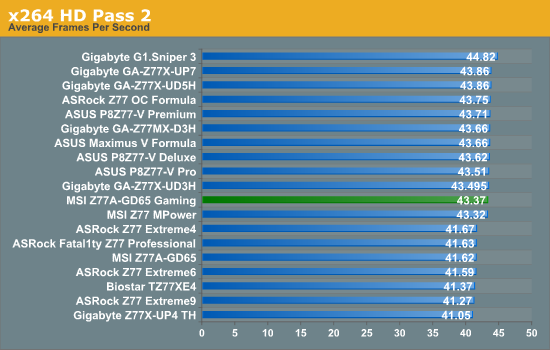










37 Comments
View All Comments
jabber - Thursday, April 18, 2013 - link
Yes a shame about those unwanted video ports. Just more unnecessary circuit traces on a very busy board.iamkyle - Thursday, April 18, 2013 - link
I'm still waiting for a manufacturer to come out with an E-ATX or XL-ATX motherboard that sacrifices the onboard junk - audio, LAN, etc and just gives me the bare essentials. Just give me USB ports and let me build the rest.With those motherboard form factors, there is PLENTY of room for 'enthusiasts' to use 3 or 4-way SLI or CF setups and STILL use a premium sound card or NIC of their choice. TRUE customizability, TRUE choice.
jabber - Thursday, April 18, 2013 - link
Yes I've always wanted a motherboard that really strips away everything an enthusiast wouldn't want. I'm pretty sure with less crap on the board it would have less noise and the traces could be shortened and widened improving stability and OC potential.TaylorSandler - Thursday, April 18, 2013 - link
Love my job, since I've been bringing in $5600… I sit at home, music playing while I work in front of my new iMac that I got now that I'm making it online.(Click Home information)http://goo.gl/dkKvy
dawp - Friday, April 19, 2013 - link
why can't we flag spammers?whyso - Thursday, April 18, 2013 - link
Why are POST times so long on desktop boards. For laptops its generally less than five seconds.Death666Angel - Thursday, April 18, 2013 - link
Because desktop boards typically include a bunch more extra hardware (USB chips, SATA chips, bigger BIOS, more memory modules etc.) and all that takes time to initialize. Laptop motherboards on the other hand are usually pretty bare bones utilizing only chipset features and not much more, the BIOS is also fairly locked down and offers only basic customization and the builder knows what will be included in the built so there is no need to search for a lot of stuff that might be installed, which shaves off even more time.IanCutress - Friday, April 19, 2013 - link
Usually due to initialisation processes. I test POST with two GPUs under Win7, and each GPU adds some time. There's also more fan controllers, headers, ports, and all the stuff connected to the chipset that you don't get in a laptop, hence the big discrepancy in time. Death Angel covers it ^^^TGressus - Thursday, April 18, 2013 - link
I've always liked the look of the Tantalum capacitors MSI uses. They should switch the remaining SMD caps out, blacken the silk screening, lead and solder.It would take extreme aesthetic to offset MSI BIOS. :(
Quizzical - Thursday, April 18, 2013 - link
"gaming WiFi" is an oxymoron, so I don't think you can reasonably fault MSI for not including it.If the GD65 is the flagship of MSI's "gaming" line and the rest have numbers that normally correspond to MSI's lower end motherboards, then they may well be taking the approach of saying, let's include the stuff that gamers need and not so much else, rather than spending the money for worthless junk like a Thunderbolt port.
There are plenty of people who want to build a gaming rig with a sub-$100 motherboard for budget reasons, though on such a budget, you're probably looking at an AMD CPU. A motherboard that offers everything that has a plausible gaming use and not much else could have a useful niche.
-----
The utility of a higher polling rate mouse has nothing to do with the frame rate. There's no good reason for a game engine to pretend that all inputs happened exactly when a new frame started. You process keyboard, mouse, and gamepad inputs as they come in, and if you don't start a new frame until 10 ms after you found out that a button was pressed, then that frame can show 10 ms worth of movement due to the button press.
A higher polling rate does only take a few ms off of input latency. Windows default for USB devices is 125 Hz, which means average input latency of 4 ms (on average, you press a button halfway between the next time that the device will be polled and the previous time), and that trivially can't be reduced to less than 0 ms.